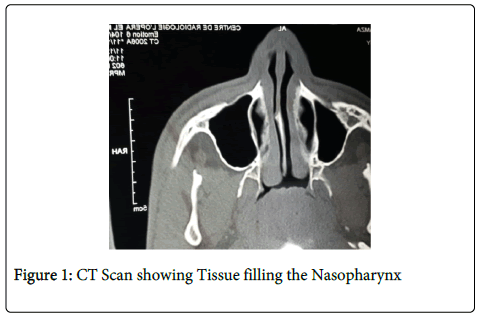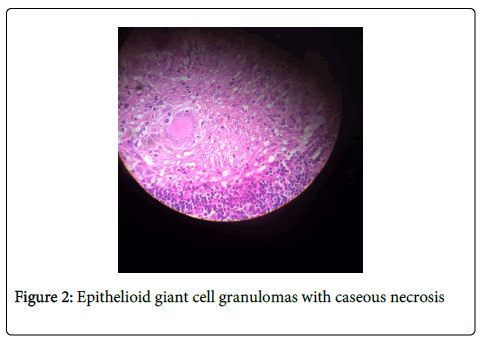Case Report Open Access
Nasopharyngeal Tuberculosis in a Case Report and Literature Review
F. El Ayoubi*, Azeddine Lachkar, Ahmed Aabach, Mohammed Chouai, Ali El Ayoubi, Mohamed Rachid GhailanCentre Hospitalier Universitaire Mohamed VI, BP 4806 60049 University Oujda, Morocco
- *Corresponding Author:
- Fahd El Ayoubi
Centre Hospitalier Universitaire Mohamed VI
BP 4806 60049 University Oujda, Morocco
Tel: +212 536 539 100
Fax: +212 536 533 554
E-mail: fahd.el@hotmail.fr
Received Date: January 27, 2015, Accepted Date: February 19, 2015, Published Date: February 22, 2015
Citation: F. El Ayoubi, Azeddine L, A Aabach, Mohammed C, A. El Ayoubi, et al. (2015) Nasopharyngeal Tuberculosis in a Case Report and Literature Review. Air Water Borne Diseases 4:120. doi:10.4172/2167-7719.1000120
Copyright: © 2015 F. El Ayoubi et al. This is an open-access article distributed under the terms of the Creative Commons Attribution License, which permits unrestricted use, distribution, and reproduction in any medium, provided the original author and source are credited.
Visit for more related articles at Air & Water Borne Diseases
Abstract
Tuberculosis is the most common infectious disease in the world, it poses a public health problem in developing countries. Nasopharyngeal localization is rare.. Clinically it presents diagnostic difficulties with neoplastic disease. The diagnosis is essentially histopathological. Treatment is based on anti-tuberculosis. Evolution is generally favorable.
Keywords
Tuberculosis; Nasopharynx; Anti-tuberculous chimiotherapy
Introduction
Tuberculosis is the most common infectious disease in the world; it poses a public health problem in developing countries. Nasopharyngeal localization is rare. The clinical unspecific can simulate a malignant tumor of the nasopharynx. We report a unique case of primary nasopharyngeal tuberculosis through which we recall the different aspects and the diagnostic difficulties of this disease.
Observation
It is a 27-year-old woman with no particular medical history, present for 1 year a right nasal obstruction becoming bilateral later, intermittent first and permanent, associated with purulent postnasal drip, without epistaxis or smell Disorders. Otoscopy found a bilateral otitis media with effusion, moreover cervical palpation found no lymphadenopathy. The nasofibrosopie showed a budding tumor and mucopurulent secretions in the nasopharynx. The scanner has an objectified tissue filling the nasopharynx (Figure 1).
A biopsy was done and allowed the diagnosis of tuberculosis in showing a epithelioid giant cell granulomas with caseous necrosis (Figure 2). The patient was put under antituberculous treatment for six months with a favorable evolution.
Discussion
Nasopharyngeal tuberculosis corresponds to all mucosal lesions due to the inoculation of bacillus, this localization is rare. It was described for the first time in 1936 by GRAFF.
The mode of contamination requires local inoculation by inhalation of dust bacillus, or dissemination through blood or lymphatic system from an unknown source from which the appearance of primary site or from a pulmonary especially known home for blood-borne or mucosal route for lymphatic [1].
It primarily affects young adults without sex predominance. Clinical signs are nonspecific: nasal obstruction, anterior and posterior purulent rhinorrhea, epistaxis, cervical lymphadenopathy, and otologic signs. These signs can simulate a nasopharyngeal carcinoma [2].
Nasopharyngeal tuberculosis can upholster several aspects to nasofibroscopy: ulceration, swelling burgeoning, regular overgrowth of the lining. The imagery is not specific, is in favor of a malignant tumor. The diagnosis of nasopharyngealtuberculosis is histological with the presence of epithelioid giant cell granulomas with caseous necrosis, all clinical, endoscopic andradiological signs are especially for a tumor etiology, hence the need for multiple biopsies at different locations in order to eliminate nasopharyngeal carcinoma or a combination [3].
The treatment of primary nasopharyngeal tuberculosis is based on a medical anti-tuberculous chemotherapy, the classic combination used is a combination therapy containing rifampicin, isoniazid and pyrazinamide for 2 to 3 months, followed by a relay hang 4-6 months combination therapy (isoniazid and rifampicin). Therapeutic efficacy is based on the regression of clinical and endoscopic signs, any abnormal changes can be related to resistance or a possibility of coexisting neoplastic disease, hence the necessity of repeated biopsies. The risk of relapse is estimated at 1% of essentially the appearance of multidrug resistant strains of BK [4,5].
Conclusion
Nasopharyngeal tuberculosis is a rare disease. Clinically it presents diagnostic difficulties with neoplastic disease. The diagnosis is essentially histopathological. Treatment is based on anti-tuberculosis. Evolution is generally favorable.
References
- Mohamed MlihaTouati(2006) The Pan African Medical Journal - ISSN 1937-8688
- Chouaid C. Actualités de la tuberculose. Rev Mal Respir 23:80–85
- Raji A, Essadi M, AitBenhamou C, Kadiri F, Laraqui NZ, et al. (1995) Aspect rare de la pathologierhinopharyngée: la tuberculosecavaire. Rev JF ORL 44:264–267
- Kharoubi S (1998) [Pharyngeal tuberculosis: an analytical study and report of 10 cases]. Rev LaryngolOtolRhinol (Bord) 119: 203-207.
- Ahmed ID,Hammi S, Jahnaoui N, Asri N, Marc K, et al. (2012) La tuberculose extra-ganglionnaire de la sphère ORL. Revue des Maladies Respiratoires. Janvier 29:A121.
Relevant Topics
Recommended Journals
Article Tools
Article Usage
- Total views: 14158
- [From(publication date):
March-2015 - Sep 03, 2025] - Breakdown by view type
- HTML page views : 9567
- PDF downloads : 4591


